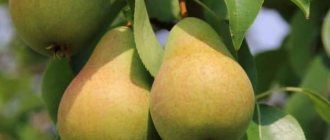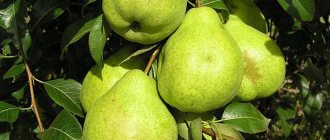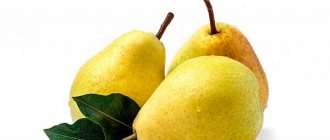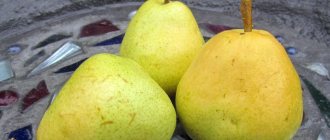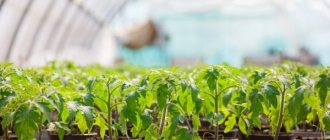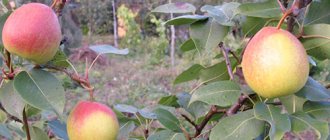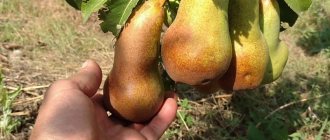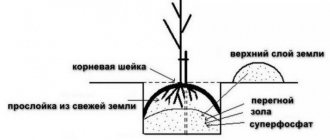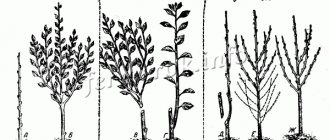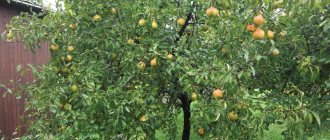Pear Conference.
Description of the variety
The Conference pear variety has been known to gardeners for quite a long time. It got its name from a pear growing conference that took place in Britain at the end of the nineteenth century. The pear was included in the State Register of the Russian Federation in 2014.
A late-autumn fruit ripening variety that can be stored for up to 6 months. The crop is grown in the southern regions of Russia, Ukraine and Crimea.
Characteristics of wood
The pear grows to a height of 4-5 meters. The crown diameter is 3-5 meters, it is wide-pyramidal and dense. Young shoots grow 40-60 cm per season. The tree can live and bear fruit for 40-60 years.
Description of fruits
Conference.
The fruits are oblong pear-shaped, weighing up to 135-150 grams, the skin is dense, matte, greenish-yellow, covered with rough red spots.
The pulp is yellowish-cream, oily, very juicy, fine-grained with a slight tart taste and pleasant aroma. Tasting assessment of taste 4.8-4.9 points out of 5 possible. The fruits are used universally; they are consumed fresh and made into aromatic jam and compote for the winter.
How to plant a pear tree correctly
The Conference variety is self-pollinating, which means the tree can grow on the site by itself. This makes life very easy for gardeners, since the pear is a large tree. Conference should be planted in a sunny, warm place, protected from winds, which can knock flowers and ovaries from the plant, and in winter contribute to freezing. You cannot place a young tree in a place where groundwater is close (above 2 m), as this is guaranteed to damage the roots of the pear.
If planted correctly, the tree will delight you with a bountiful harvest.
Pear loves light, loose soils that retain moisture but do not accumulate it. In terms of acidity, the earth should be slightly alkaline or neutral (pH from 5.9 to 6.5). The ideal option would be chernozem, forest gray soil or loose loam. If your site has heavy silty, clay or peaty soil, it will need to be lightened by adding river sand. Too light sandy or sandy loam soil is also not suitable for pears - the plant will not be able to take root properly and the tree will receive few nutrients. Such land will need to be fertilized more intensively, mulched more abundantly, and watered more often.
Choosing the right place to plant a pear is the key to tree health and abundant harvests.
A sunny south-west, south or south-east slope of a gentle hill, protected from north and north-west winds, is ideal for the Conference. You should retreat at least 5 m from the nearest wall or high fence, and also 3–3.5 m from other trees.
Deadlines
You can plant a pear both in September (if you live in the southern region) and in April (if you are worried about the seedling). Preference should still be given to spring planting, since the Conference is very sensitive to frost and the young tree may not survive the winter. In any case, you need to prepare the soil for the plant in the fall, at least 2 weeks before planting, that is, in mid-September.
If your site has a high groundwater level (less than 2.5 m from the surface), then first you need to create a hill for the seedling about 1 m in diameter and at least 60 cm high.
Pit preparation
- Remove the top 15–20 cm of soil and set it aside to later place in the base of the hole.
- Dig a hole 80 to 100 cm wide and 60 to 80 cm deep.
The correct planting hole for a seedling has a depth of at least 60 cm and a width of at least 80 cm
- If the soil is light and sandy, pour 7 liters of earth mixed with powdered clay in equal proportions to the bottom of the hole. In heavy soil you need to add 10–15 liters of river sand.
- Add 60 g of phosphorus or potassium fertilizers, for example, potassium nitrate, into the pit.
- Mix the soil removed from the top with 1 liter of wood ash.
- Pour the finished mixture into the hole and form a mound.
- Cover the hole with any waterproof material.
Selection of seedlings
A pear seedling should be selected that is 1–2 years old with strong branches. To check the quality of the plant, carefully examine its roots: there should be no dry or rotten shoots among them. Also test the strength of the branches by bending them a little. A healthy plant will not break. You need to buy planting material from trusted manufacturers.
Step by step planting process
The seedling must be planted within a week after purchase, making sure that its roots do not dry out. And the day before, it is necessary to place the tree in a 3% manganese solution to disinfect the root system. Instead of potassium permanganate, you can use a growth stimulator, for example, Epin, Zircon or Heteroauxin. Next, the planting process should proceed as follows:
- Remove the seedling from the aqueous solution and cover its roots with a mixture of manure and clay (prepared in a 2:3 ratio) and leave to dry for 2 hours.
- Remove the protective film from the hole, insert a support stake into the center of it, which should be 1.5 times higher than the seedling.
- Place the tree in the center of the hole and carefully distribute its roots over the entire area. The root collar of the tree should be 7–9 cm higher than the final soil height.
- Fill the hole with earth, laying it in layers and constantly compacting it so that no voids form.
- Tie the seedling to a support.
- Around the tree, make a ring ditch for irrigation with a depth of 7–9 cm and a radius of 45–55 cm.
- Pour 35–40 liters of water, pouring it into the ditch gradually, allowing it to soak in.
- Mulch the root circle with peat chips, compost or other suitable material.
Be sure to mulch the young tree to avoid rapid loss of moisture
- Make the first pruning of the tree, shortening the main trunk by a third, and the branches by 2/3 of the length.
Video: how to plant a pear correctly
Reviews
Ilona
Orlovsky
Pear Conference has been growing here for a very long time. The yield is high. I make compote and jam from pears that fell from the tree. Those that I pick from the tree I put in storage. We don’t have them for a long time, our children and grandchildren love them very much, so they eat them up quickly.
Violet
Erofeevka
I would like to say about the Conference pear that in our climate it grows well, but if the summer is rainy, it is a little affected by scab. And it tolerates winter well. Pears are tasty, juicy and sweet. They stay until March.
Victor
Novokubansk
Since childhood I remember the taste of pear Conference. She is growing up with my parents in the village. I help my father take care of the garden. We prune the tree in the spring, since the crown is thick, feed it, and treat it against diseases and pests.
Watering and fertilizing
Caring for the Conference pear is not difficult, but it does have its own characteristics. First of all, they relate to the schedule according to which the tree is watered.
The intensity of water application depends on the age of the plant. For example, one- and two-year-old seedlings are watered daily, pouring 10 liters of water under each plant. If there is no sun, the procedure can be reduced to several times a week (Figure 5).
Figure 5. Young seedlings should be watered more often than mature trees
When the tree reaches the age of 3-6 years, watering is reduced to once a week, but 30-40 liters of liquid are added per watering. Mature trees over 6 years old are watered only twice a month, but up to 6 buckets of water will have to be poured under one such plant.
This variety of pear should be grown taking into account the fact that in spring and autumn the tree requires feeding:
- If nutrients were added to the hole during planting, additional feeds do not need to be added in the first two years.
- Starting from the second year, a mixture of complex fertilizers (35 grams), urea (25 grams) and potassium sulfate (30 grams) is added annually to the tree trunk circle.
- In the spring, just before flowering begins, it is advisable to spray the trees with a solution of copper sulfate or urea.
In autumn, trees begin to prepare for winter, so it is advisable to feed them with nitrogen preparations immediately after harvesting. In addition, once every three years, during the autumn loosening of the soil on the tree trunk circle, humus is introduced into the ground.
Landing
The root system of young seedlings is sensitive, and therefore, proper planting can significantly affect the development of the young tree. Detailed instructions and advice on the correct planting of the Conference pear variety can be found in the articles at the link below.
How to plant a pear tree correctly
At what distance to plant pears?
How to choose pear seedlings
How to replant a pear
Where and how was the variety bred?
The variety's unusual name for a fruit, Conference, has an interesting history. This pear hybrid was created by British breeders at the end of the 19th century by crossing a wild pear with the European cultivated pear variety Leon LeClerc de Naval. They presented the new product at the world gardening conference, after which the fruit acquired a name.
In Europe, the Conference pear has been cultivated for almost a century and a half. This species reached the CIS countries and Asia only in the 20th century.
The Russian variety of pears, Bryansk Beauty, is similar in shape and taste to the Conference. The spotted skin makes the Conference similar to pears from the Bere group of varieties.
Care
The pear responds well to anti-aging pruning, fertilizing and timely watering. Agricultural technology is not complicated, but requires strict execution. More useful information and recommendations for growing Conference trees can be found by clicking on the links below.
How to care for a pear Pruning a pear Pruning a columnar pear Treating a pear from diseases and pests Feeding a pear How to water a pear
Harvest and storage
Pears of this variety are ideal for making desserts and canning.
A tree grafted onto quince cuttings takes 3-4 years to bear fruit, and the use of pear rootstock begins to harvest in 5-6 years. Fruit ripening occurs in the third ten days of September. The tree produces up to 45 kg of fruit. It is recommended to remove pears of this variety when they are unripe. They should be placed in a bright and cool place and after a week, the flesh will be juicy, grainy and sweet.
Choose sunny weather to collect fruits. Fruits should not be removed after rain and in the morning when they are covered with dew. The harvest is laid out in one layer for 2-3 days in a dry place. During this time, the pears evaporate moisture to extend their shelf life. The fruits are stored at a temperature of 1-2 ° C and a humidity of 85-95%.
It is not recommended to place pears in paper or plastic bags or cardboard boxes. Condensation forms in such tanks, which leads to the development of fungal diseases.
It is better to store the harvest in plastic or wooden boxes. At the conference, pear varieties are prepared into preserves, jams, compotes, jams, marshmallows, and pie fillings. They can also be eaten fresh.
Diseases and pests
The Conference pear variety has average resistance to fungal diseases and pests. Therefore, it requires regular preventive treatments. At the first manifestations of disease, it is important to start treatment, and this will lead to good results. You can read about all the details of prevention and treatment below.
Dangerous Pear Pests
Pears often suffer from pests, they affect the leaves, bark and fruits.
In this article, we have selected 11 of the most harmful insects that harm pear trees, and also ways to destroy them.
Diseases of pear trees
To get what they cherish, gardeners have to work hard, and the reason for this is pear diseases.
Read about 19 common pear diseases and how to combat them.
Advantages and disadvantages of the Conference
Despite the undoubted advantages of Conference pear varieties, they are not without disadvantages
Among the undoubted advantages of the variety are:
- Quite early after planting the seedling in a permanent place, abundant and regular fruiting in suitable climatic conditions.
- Self-pollinating. The Conference pear does not require pollinating varieties. Pollen viability is up to 80%. This is especially true for gardeners with small plots, since even one pear tree takes up quite a lot of space. If you have enough area for several trees, Conference is an excellent pollinator for most pears. The best varieties for her are Goverla, Striyskaya, Kucheryanka.
- The taste qualities of the fruit make them suitable for both amateur gardeners and farmers who grow pears for sale on an industrial scale.
There are also some disadvantages, which include:
- Relatively weak winter hardiness. The pear is guaranteed not to survive temperatures below -18…-20 ºС.
- Dependence of fruiting on summer weather conditions. If the weather has been cold, cloudy, rainy and windy, the pears will not ripen or develop their characteristic flavor. They are very dependent on the sun, which is necessary for the proper ripening of fruits.
- Some note the not very presentable appearance as a drawback. But one can argue with this, because the main thing is taste.
- Susceptibility to diseases of fruit trees caused by fungi.
Fruits and yield
The conference produces sweet, juicy fruits. They are oblong in shape and large. Color: yellow-green. The fruits are not attractive in appearance. They are loved for their taste characteristics. The skin on their surface is pockmarked and rough. Covered with brown specks. The pulp is sweet-sour, aromatic. Cream color. Due to the peel, the taste is particularly astringent.
1 fruit weighs 180 grams. This size is considered medium. The fruit contains 14% sugar, which confirms its taste characteristics. Thanks to its thick skin, it is used for long-distance delivery. The yield level is assessed as high. From 1 tree you can harvest 40 kg of conference pears. The fruits are considered low-calorie and are used in dietary nutrition.
Characteristics of wood
In order not to confuse the selected variety with other representatives of pears, you need to know exactly its key characteristics. The conference is characterized by a spreading crown, which must be trimmed annually for proper formation and development. Also read about the features of the Chinese pear variety in this material.
The Conference variety grows quickly and enters the fruiting season early.
Pollinator varieties
Most of the ovaries are formed during self-pollination of the tree, and the variety itself often acts as a pollinator for other crops. However, experienced gardeners recommend placing varieties such as:
- Williams;
- Bere;
- Clapp's favorite;
- Chizhovskaya;
- Carmen;
- Duchess.
Pollinators must be planted no further than at a distance of 80-100 meters, otherwise cross-pollination will not occur.
Tree height
The following features are characteristic of a tree of this variety:
- tall, trunk length can reach 4.5-5.5 meters;
- rapid growth, each season the plant “stretches” by 60-70 cm;
- spreading crown, the diameter of which reaches 5-6 meters;
- the need for regular formative and sanitary pruning;
- tendency to thicken, abundant dense foliage.
Lifespan
The rootstock of pears does not affect their yield and other characteristics, but it does affect their lifespan and fruiting time:
- conference, grafted onto a forest pear, can live from 90 to 200 years, depending on the climate zone and care;
- Grafting on quince accelerates fruiting, but reduces life expectancy to 35-45 years.
Winter hardiness
The conference pear variety is adapted mostly to southern regions with a stable warm climate. Regardless of care, rootstock and winter shelters, the plant is not able to survive cold temperatures below -18 degrees Celsius. At lower winter temperatures, fruit branches freeze slightly and sometimes even die.
The tree reacts poorly to returning spring frosts; with sudden cold snaps at this time of year, the growing season slows down and yields drop.
Productivity
One of the significant advantages of the variety is its high yield. The tree consistently produces a large amount of juicy and sweet fruit. On average, it is possible to collect about 40-45 kg of fruit from one plant; with careful care and favorable weather conditions, these figures can be higher. This article will tell you about the benefits and harms of pears.
The fruit on the branch does not ripen completely. At the time of collection, the fruits are not ready for consumption; ripeness comes with time if properly stored.
Cyclicity of fruiting
The fruiting process is characterized by the following features:
- early fruiting, the first fruits are formed in the 4-5th year of the tree’s life;
- abundant flowering, flowers are large and fragrant, with five snow-white petals;
- a small amount of barren flowers, almost all flowers bear fruit;
- stability of fruiting, the conference is not characterized by age-related periodicity, the years of fruiting come one after another, there are no lean seasons.
Self-fertility
The tree is capable of self-pollination. Most of the ovaries, about 60-70%, are formed from self-pollinated flowers. Pollinator varieties are used exclusively to change the characteristics of a variety, increase its resistance to disease and improve its taste. Self-pollination occurs depending on weather conditions; with high humidity, the percentage of self-pollinating ovaries decreases.
Disease resistance
Genetically, the variety has weak immunity. Trees often suffer from:
- Scabs. For prevention, trees should be sprayed with Bordeaux mixture and all affected areas should be removed;
- Septoria. Timely spraying with fungicidal preparations helps against this infection;
- rust on foliage, leading to inhibition of vegetation processes. Manifests itself with a lack of copper;
- powdery mildew, spray against it with a solution of laundry soap and soda ash.
Description of the fruit
The main characteristic of fruit plants that gardeners are most interested in is the characteristics of the fruit.
Externally, conference pears look unattractive; brown, rough spots spreading across the skin spoil its appearance.
However, the taste and size, as well as the quantity of fruit, have made the variety one of the most widespread in the world.
Calorie content
The fruits of the conference are low in calories, for this reason they are recommended for dietary nutrition. On average, there are about 42 kcal per 100 grams of product. The pulp also contains many micro and macroelements: potassium, calcium, sulfur, boron, cobalt, iron, zinc, iodine, manganese and others. A rich complex of vitamins has a positive effect on the immune system:
- C, ascorbic acid;
- B5, pantothenic acid,
- PP, niacin;
- Vitamin A;
- Vitamin E;
- biotin;
- folic acid.
Taste
Excellent taste is what made this pear variety famous. The pulp of freshly picked fruits is pale pink, densely grained, and has a pronounced sourness. Over time, the fruits mature and ripen. Ripe pears are sweet and aromatic, their flesh is tender and melts in your mouth.
The average tasting rating of the expert commission is 4.6 on a five-point scale. Taste qualities are preserved for a long time and do not disappear during transportation and storage.
Fruit size
The fruits of the conference variety are quite large in size. On average, the weight of one fruit ranges between 100 and 200 grams. Dimensions largely depend on the breed conditions and the quality of planting care. The shape of a pear is easily recognizable: the rounded large base sharply turns into an elongated oblong neck. The petiole is held tightly to the branch; the fruits do not fall off for a long time after reaching maturity and harvesting time.
Usage
Pears of this type are used for:
- fresh consumption;
- juice production;
- making jams and preserves;
- cooking compotes;
- dried fruit preparations.
Considering the rich composition of the pulp, it should be noted that all products are suitable for baby food, consumption by pregnant women, and the elderly.
Pros and cons: is it worth planting?
The positive properties of the Conference include the following characteristics:
- drought resistance;
- self-pollinating;
- rapid tree growth;
- abundant fruiting;
- wonderful taste of fruit;
- good keeping quality;
- high degree of transportability.
Disadvantages include the low winter hardiness of the Conference and dependence on climatic conditions. In cold, rainy summers, the fruits will be tasteless.
Selecting a location and preparing a planting hole
We water the seedling well.
For good growth and development of the pear, the planting site must meet certain requirements. This should be a well-lit place protected from strong winds and drafts. The southern or eastern part of the site is suitable for the Conference. Groundwater in the area should be at a depth of at least 3-3.5 m. Pears grow poorly on heavy and waterlogged soils. You also need to take into account that the Conference pear, in accordance with the description of the variety, is a large tree that requires a lot of space.
It is also necessary to properly prepare the planting hole. In order for the seedling to take root easily, dig a hole 1 m wide and 0.5-0.6 m deep, but if the root system is larger, then the depth must be increased (up to 1 m). Gardeners recommend filling the hole with 2-3 buckets of a mixture consisting of compost, peat, and river sand. This will improve the quality of the soil, provide the seedling with an initial supply of nutrients, and good structure and looseness will speed up rooting. The bottom of the planting pit must be well loosened so that the process of oxygen supply is more intense. When preparing the hole, you need to drive in a support to which the seedling is fixed so that it grows evenly and the trunk does not bend when strong winds occur.
History of selection and region of breeding
The Cathedral pear was bred at the Moscow Agricultural Academy (MSHA). The authors of the variety are breeders S. P. Potapov and S. T. Chizhov. This variety was obtained by crossing two varieties - Forest Beauty and a hybrid of Forest Beauty with Duchess Hip .
Bred for breeding in the Central zone , however, due to frost resistance, it can grow even in temperate Northern regions. It passed the state test in 1990, and in 2001 it was included in the State Register in the Central Federal District.


